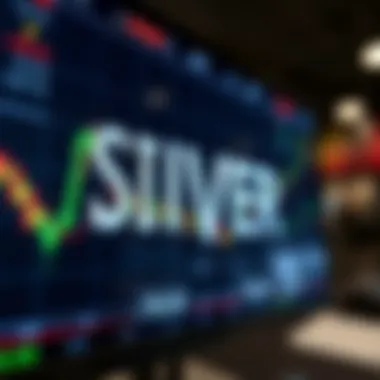The Essential Guide to Silver Ticker Symbols


Intro
In the world of financial trading, understanding the fundamental aspects of commodities is essential, especially for those looking to invest in precious metals like silver. This article intends to unpack the various nuances surrounding silver, particularly its ticker symbol and its role in the broader financial landscape. For investors, financial planners, and even students, knowledge of how silver is traded can be the difference between gain and loss, making it vital to grasp the intricacies involved.
Silver's ticker symbol, often represented as "SI," holds significant value in the marketplace. It acts as a shorthand reference for traders, providing quick access to market data, price changes, and overall trading volume. Much like any other asset class, comprehending how to navigate silver’s ticker—and the many platforms out there for trading—is imperative for making informed decisions.
As we move deeper into this guide, we will explore essential investment terminologies, analyze financial products related to silver, and provide practical examples and strategies to help investors leverage this valuable asset. Understanding these fundamentals can empower participants in the market to act strategically and confidently.
Investment Dictionaries
Terminology Breakdown
To fully grasp the essence of silver trading, it’s important to familiarize oneself with key terminologies that are often thrown around in the financial arena. Here’s a glossary designed to break down these terms:
- Ticker Symbol (SI): The specific acronym used on trading platforms to represent silver.
- Spot Price: The current market price at which silver can be bought or sold for immediate delivery.
- Futures Contract: A legal agreement to buy or sell a certain amount of silver at a predetermined price on a specified date in the future.
- ETF (Exchange-Traded Fund): A type of investment fund that trades on stock exchanges, much like stocks, often tracking the price of silver.
- Leverage: Using borrowed capital for investment, which can amplify both gains and losses.
Understanding these terms lays a solid foundation for recognizing how the silver market operates and helps in making sense of trading strategies available.
Practical Examples
Consider a scenario where an investor is looking to buy silver. Using the ticker symbol SI, they can quickly access real-time market data on trading platforms like Robinhood or Interactive Brokers. Let’s say the spot price of silver is $24.50 per ounce. If the investor decides to enter a futures contract for a delivery date six months from now, they might contract for 100 ounces at the current price, betting that the value will increase over this time.
Another example involves ETFs. If an investor opts for the SLV ETF, which tracks silver prices, they are essentially purchasing shares that represent ownership in the silver held by the fund. This route is often less complex than trading physical silver, and provides a way to diversify risk.
Understanding how these different products interact with the ticker symbol SI gives investors a more nuanced view of market mechanics, better equipping them to make informed decisions.
"Knowledge is power, especially in finance—knowing when and how to buy can turn the tides in your favor."
With this groundwork laid out, the following sections will dive deeper into the pros and cons of various financial products linked to silver, guiding readers step-by-step through informed investment practices and strategies.
Prolusion to Silver as an Investment
The allure of silver has attracted investors for centuries. It's not merely an asset; it’s a complex blend of a rich historical legacy, market dynamics, and diverse applications that add to its charm. The importance of understanding silver as an investment lies in its multifaceted nature, which can serve a variety of objectives for both seasoned and novice investors alike. Not only does silver have historical significance, but its physical and digital trading aspects also provide numerous avenues for engagement.
Defining Silver's Role in the Market
Silver occupies a rather distinctive place in financial markets. As a precious metal, it stands as both a commodity and a form of currency. Its value often moves inversely to that of currencies, particularly the US dollar. Investors frequently turn to silver during economic uncertainties, making it a safe haven akin to gold.
Furthermore, silver has industrial applications which continue to drive demand. For example, in electronics and solar technologies, silver's conductive properties are indispensable. This dual role as both a prized investment and a raw material for industries sets silver apart from other commodities.
- Safe Haven Asset: Like gold, investors flock to silver during turbulent times.
- Industrial Demand: Industries utilize silver for its unique properties, ensuring a steady demand.
- Portfolio Diversification: Including silver in a portfolio can mitigate risks associated with other investments.
Historical Importance of Silver
The history of silver is woven through the fabric of human civilization. Ancient cultures prized silver for its beauty and rarity, using it for currency and trade long before gold assumed its status. In the context of modern finance, silver has held various positions, shaped by socio-economic indicators and geopolitical events.
- Standard of Value: Throughout history, silver served as a standard for monetary systems. Countries used silver coins as legal tender, which profoundly influenced trade and economics.
- Crisis Indicator: During financial crises, historical data suggests that silver often spikes in value, providing investors a protective mechanism during downturns.
- Cultural Significance: In many societies, silver symbolizes wealth and prosperity, making it a sought-after item among treasure hunters and modern collectors alike.
In essence, silver's historical significance cannot be understated. It's not just a reflection of market trends but a lens through which to view the evolution of trade and value systems. Understanding its role helps investors grasp how silver has maintained its relevance in modern finance and why it continues to attract attention.
Continually fluctuating, yet consistently remarkable, silver travels through time as an investment with stories to tell, transformations that mark its journey and a steady presence that captivates those wise enough to pay attention.
The Ticker Symbol for Silver
The ticker symbol for silver plays a pivotal role in the financial landscape, serving as a shorthand representation used throughout trading and investment platforms. Understanding this symbol is essential for investors, financial planners, and anyone interested in the dynamics of silver as a commodity. This section will delve into the nuances of ticker symbols, their importance in the trading ecosystem, and the specific identifier used for silver.


Understanding Ticker Symbols
Ticker symbols are like a second language in the world of investing. They are unique identifiers assigned to publicly traded companies, commodities, and other assets. Each ticker symbol can consist of letters, numbers, or a combination of both, providing a quick reference for traders and investors alike.
- Purpose: The main aim of having ticker symbols is to simplify the way market participants track and trade assets. Investors don’t have all day to sift through lengthy descriptions; they need quick references that are instantly recognizable.
- Design: Ticker symbols are usually concise. For instance, a well-known stock might have a three-letter ticker, while commodities can be slightly longer. The design and format depend on where the asset is traded.
- Market Efficiency: By using ticker symbols, transactions can happen faster. This is crucial in the high-stakes world of trading where every second counts.
The familiarity with these symbols can also help in avoiding confusion. As silver is traded not just as a metal but also as shares in ETFs and futures, knowing its ticker can significantly enhance a trader’s efficiency.
Silver's Commonly Recognized Ticker
In the world of financial markets, silver holds a special status, and its ticker symbol reflects this. The most widely recognized ticker symbol for silver is SI. This is specifically used for futures contracts on the COMEX, which is part of the CME Group. Other common identifiers include:
- SLV: This is the symbol for the iShares Silver Trust, an exchange-traded fund (ETF) that aims to reflect the performance of the price of silver.
- SIVR: Another ETF, the Sprott Physical Silver Trust, also utilizes this ticker.
Each of these tickers provides a different avenue for investors looking to gain exposure to silver. Here’s what you might consider about each:
- SI: Good for those looking into futures trading. It offers leverage, but also comes with higher risk given the volatility of futures contracts.
- SLV and SIVR: These ETFs provide a more straightforward way to invest in silver without delving into futures trading. They are more like purchasing a stock, making them preferable for many retail investors.
"Understanding the ticker symbols for silver can make the difference between a sharp investor and a lost novice in the bustling market."
In summary, grasping the significance of silver's ticker symbols not only aids in efficient trading but also empowers investors to navigate the complexities of the silver market industry with confidence and skill.
Trading Silver: Where and How
Silver trading is a topic of high relevance for investors and financial planners, especially in an era where precious metals hold a unique position in the investment landscape. Knowing where and how to trade silver effectively ensures that one can not only take advantage of market fluctuations but also mitigate risks associated with this particular commodity. The importance of identifying the right platforms and methods for trading cannot be overstated; doing so enhances the potential for profit while maintaining investor confidence.
Popular Trading Platforms for Silver
The choice of trading platform can significantly affect an investor's experience and outcome. Some of the most common platforms include established stock exchanges, online brokers, and specialized commodity trading platforms. Investors often gravitate towards these options based on factors such as fee structures, ease of use, and available tools for analysis.
- New York Mercantile Exchange (NYMEX): This is a leading market for trading silver futures, providing a centralized place for large-scale trading that can influence the global price of silver.
- London Bullion Market Association (LBMA): Known for its role in the over-the-counter market, it primarily caters to institutional investors and offers a platform for spot trading of silver and other precious metals.
- Interactive Brokers: This online broker gives direct access to numerous global markets, allowing investors to trade silver in various forms, including ETFs and futures.
- eToro: Known for its user-friendly interface and social trading features, eToro appeals to newer investors interested in trading silver via CFDs (Contracts for Difference).
- XM: A platform that focuses on making currency and commodity trading accessible, XM allows for leveraged trading in silver, thus attracting a different investor demographic.
When selecting a platform, it's crucial to consider elements like transaction fees, liquidity, and the variety of trading options available.
Physical vs. Digital Trading
The method of trading silver often comes down to choosing between physical silver investments like coins and bars, and digital options such as ETFs or commodities through online trading platforms. Each route has its unique advantages and challenges.
- Physical Silver: This involves purchasing actual silver materials, which can serve not just as financial investments but also as tangible assets. Investors appreciate the intrinsic value of having something concrete in hand. However, one must consider storage costs, insurance, and potential difficulty in liquidity during emergencies.
- Digital Silver: This method typically includes purchasing shares in a silver ETF or speculating on futures contracts via online trading. The benefits here include easier accessibility, lower transaction costs, and quicker liquidation options. However, there’s a lack of physical ownership, which may deter some conservative investors.
Market Dynamics of Silver
Understanding the market dynamics of silver is crucial for any investor looking to navigate its complexities. Silver is more than just a precious metal; it behaves uniquely under various economic conditions. Investors need to grasp how these dynamics affect the price and availability of silver, as it can significantly impact investment returns and strategies.
Factors Influencing Silver Prices
Several factors can sway silver prices, sometimes in unpredictable ways. Here are a few key elements that every investor should consider:
- Supply and Demand: The most basic principle is that when the demand for silver rises while the supply remains constant or diminishes, prices are likely to shoot up. Conversely, an increase in supply, without a corresponding rise in demand, can drive prices down.
- Economic Indicators: Economic health indicators such as GDP growth, employment rates, and inflation can impact silver prices. In times of economic uncertainty, investors may flock to silver as a safe haven, consequently driving its price higher.
- Interest Rates: The relationship between interest rates and silver is often counterintuitive. Higher interest rates can lead to a decline in silver prices as the opportunity cost of holding non-yielding assets like silver increases.
- Geopolitical Tensions: Situations of unrest can also contribute to increased interest in silver, leading to spikes in its price. Investors often turn to silver during global conflicts as a hedge against uncertainty.
- Industrial Demand: Silver is not only considered a hedge against inflation or economic downturns but also plays a crucial role in various industrial applications, especially in electronics and renewable energy sectors. Changes in technology can shift demand significantly.
This intricate relationship of factors makes it essential for investors to stay updated and vigilant.
Correlation with Other Commodities
Silver rarely operates in isolation. Its price can be closely related to other commodities, notably gold and oil. Understanding these correlations can offer valuable insights into trading strategies and future predictions:
- Silver and Gold: Historically, silver often has a positive correlation with gold. When gold prices rise, investors often gravitate towards silver, which can lead to increased prices for both metals. However, during specific periods, their correlation can weaken, so it’s important to watch the trends.
- Oil Prices: An increase in oil prices tends to have a ripple effect across various commodities, including silver. When oil prices rise, costs for mining operations can increase; thus, affecting the supply side. Moreover, if oil prices increase due to geopolitical tensions, the demand for silver as a safe-haven asset can also rise.
- Currency Value: Silver prices often inversely correlate with the strength of the US dollar. When the dollar weakens, silver becomes cheaper for foreign investors, typically driving its price up. Conversely, a strong dollar can lead to lower silver prices as it decreases the buying power of foreign currencies.


"Understanding how silver interacts with other commodities can provide investors with a more complete picture and help them position their portfolios accordingly."
Staying ahead of these dynamics demands consistent research and adaptability in one's strategy. Without a doubt, proactive engagement with market trends is key for success in silver investments.
Investing Strategies for Silver
When looking at silver as an investment, it’s essential to have a clear strategy. This not only helps to navigate the ups and downs of market dynamics but also positions investors to take advantage of potential opportunities. Investing in silver can provide a hedge against inflation and economic uncertainty. However, one must consider the variety of methods available when it comes to capitalizing on this precious metal.
Long-Term Investment Considerations
Investing in silver can be akin to planting a tree; it requires time and patience to see substantial growth. Long-term investment in silver tends to be less volatile compared to quick trades, which can often resemble a rollercoaster ride without a safety harness. Investors looking at silver from a long-term perspective should consider factors such as historical price trends, industrial demand, and how geopolitical events might play into silver's perceived value.
The following points highlight key considerations for those eyeing silver as a long-term hold:
- Volatility: Historically, silver prices have experienced fluctuations. Understanding the history can provide context for future price movements.
- Industrial Demand: Unlike gold, silver has significant uses in industries such as electronics, solar energy, and medical applications. Monitoring these trends helps predict future price movements.
- Economic Indicators: Evaluating macroeconomic factors, like inflation rates and currency strength, can offer insights into potential price shifts.
It’s beneficial to have a diversified investment portfolio that includes silver. This diversification acts like a cushion during economic downturns, potentially balancing out losses in other assets.
Short-Term Trading Techniques
For those inclined to short-term trading, silver trading can be an exhilarating experience. Quick trades can offer substantial returns, but they come with their own set of risks. As the adage goes, “time is money,” and in the world of trading, the ability to act quickly can make all the difference.
Engaging in short-term trading requires a different mindset and skill set. Here are some techniques that may be effective:
- Technical Analysis: This involves analyzing price charts and patterns to forecast upcoming price movements. Familiarity with candlestick patterns and volume indicators can provide clues for timing buy or sell orders.
- Day Trading: Some traders opt to purchase silver assets in the morning and sell them the same day to capitalize on intraday price shifts. This method requires constant market monitoring, akin to a hawk watching its prey.
- Market News Response: Traders must keep an ear to the ground when it comes to market news. Economic reports, trade agreements, and geopolitical developments can all stir the pot.
Short-term trading isn’t for the faint-hearted. It's crucial to keep emotions in check and make decisions based on analysis rather than impulse. Timing the market can be tricky, but with practice, it can yield significant rewards.
"The markets can be fickle, but those who understand their intricacies can find ways to profit from every twist and turn."
Evaluating Silver as a Hedge Investment
In times of economic uncertainty, investors often seek safe havens to protect their assets. This is where evaluating silver as a hedge investment comes into play. Silver has long been viewed as a reliable means of wealth preservation, especially in turbulent markets. Its physical form provides a tangible counterbalance to more volatile securities, making it particularly appealing for investors keen on safeguarding their portfolios.
Historical Performance during Economic Downturns
Historically, silver has exhibited unique traits during economic downturns. It tends to respond differently than stocks or bonds, which can plummet when the market turns sour. For instance, during the 2008 financial crisis, while many investors saw significant losses in equities, silver prices managed to rebound impressively. This can be attributed to several factors:
- Increased Demand: When economic stability wavers, people often gravitate towards precious metals as a way to preserve value.
- Safe Haven Demand: As currency values fluctuate, silver, like gold, becomes a trusted asset in which to invest.
- Industrial Uses: Silver’s application in various industries can often insulate it from severe price drops, owing to constant demand in areas like technology and manufacturing.
More specifically, from 2007 to 2010, silver's price surged from about $13 to nearly $30, showcasing its capability to act as a buffer in uncertain times.
Silver vs. Other Hedging Options
While some investors may turn to gold or real estate as hedging options, silver has certain advantages that can make it a favorable choice. Here’s how silver stacks up against other common hedges:
- Liquidity: Silver provides high liquidity, enabling quick conversions into cash without significant losses.
- Lower Price Point: Compared to gold, silver is more accessible for average investors, allowing greater quantities to be purchased for the same investment capital.
- Dual Role: Not only is silver a hedge against inflation, but its industrial demand means it can also generate returns during economic upswings.
Don't forget the significance of diversifying one's portfolio, too. By including silver alongside other assets, investors can achieve a balance that potentially enhances overall financial stability.
"Silver might not shine as brightly as gold, but its resilience offers a solid ground for those navigating the stormy seas of the financial markets."
Regulatory Aspects of Silver Trading
Silver trading is pivotal to understanding its broader role in the economic sphere. The regulatory framework governing this market ensures that trading is fair and transparent. This section sheds light on compliance protocols and reports essential for any serious investor. Understanding these regulations is not merely academic; it shapes how investors engage with silver markets, influencing everything from trading strategies to compliance costs.


Compliance and Reporting Requirements
Compliance in silver trading covers a range of requirements that investors must adhere to. These include:
- Registration: Traders must register with the appropriate regulatory bodies, which could vary by jurisdiction.
- Transaction Reporting: Regular reporting of trading activities is necessary. This helps in monitoring market activities, identifying trends, and preventing market manipulation.
- Record Keeping: Maintaining detailed records of transactions is critical.
Investors must familiarize themselves with laws that can impact their investment decisions. Penalties for non-compliance can be severe, ranging from hefty fines to restrictions on future trading.
"Understanding compliance is as crucial as understanding market trends. Ignorance can cost you dearly."
Key Regulatory Bodies in the Silver Market
Navigating through the silver market is not a solo venture. Several regulatory agencies play roles in shaping and enforcing trading standards:
- Commodity Futures Trading Commission (CFTC): This U.S. agency oversees the futures and options markets and is essential in regulating silver as a commodity.
- Securities and Exchange Commission (SEC): While primarily focused on stocks and bonds, the SEC still influences silver investment structures, particularly with ETFs.
- Federal Trade Commission (FTC): The FTC plays a part in protecting consumers from misleading practices in the silver trade.
Each body has distinct functions but collaborates to maintain the integrity of the silver market. Investors must stay updated on any shifts in regulations that these agencies introduce, as they can have profound implications on trading behavior and investment value.
Understanding regulatory aspects is critical for robust investment strategies. Investors who grasp these elements will find themselves better prepared to navigate the complexities of the silver market.
Emerging Trends in Silver Investments
Emerging trends in silver investments are becoming increasingly important for a variety of stakeholders, including investors, financial planners, and researchers. As the global landscape shifts, knowledge of these current movements becomes crucial for making informed decisions. The silver market isn't static; it's influenced by a myriad of factors ranging from technological evolution to changes in consumer preferences. Grasping these trends can significantly enhance one’s investment strategy, helping to navigate turbulent waters effectively.
Impact of Technological Advances
Technology is reshaping the way we engage with commodities, and silver is no exception. One of the most notable advances is the digitization of trading platforms. These platforms allow for real-time trading and investment analytics, providing investors a comprehensive toolkit to make timely decisions. For example, a trader might use a mobile app to monitor live silver prices and execute trades based on up-to-the-minute data. This immediacy can be the difference between profit and loss, especially in a notoriously volatile market like silver.
Additionally, mining technologies have made strides in efficiency and sustainability; for instance, techniques such as automated sorting and geospatial analysis are being utilized to enhance extraction processes. These innovations not only lower costs but also improve the overall environmental footprint of silver mining.
"Technological advancement is not just a boon; it's a tool for the astute investor in the silver market."
With these developments, investors are better equipped to make data-driven choices. Moreover, blockchain technology is making waves in terms of traceability, adding a layer of security and authenticity. Investors are now more conscious about the origin of their silver, reflecting a growing trend of accountability and transparency in trading practices.
Sustainability and Ethical Considerations
In today’s conscientious market, sustainability is at the forefront of many investment discussions, including those surrounding silver. As demand for silver continues to climb, partly due to its applications in renewable energy technologies, concerns about environmental impact grow as well. Investors now consider what they are supporting with their money.
Many market participants are advocating for ethical sourcing of silver, which can mean seeking suppliers that practice environmentally friendly mining methods. Companies that prioritize sustainable practices often find themselves in a favorable position with consumers, who are increasingly willing to pay a premium for ethically sourced products.
Investors should pay attention to silver mining companies that are transparent about their environmental impacts and efforts in sustainability. Regulatory frameworks are also tightening around these issues, making it vital for investors to stay informed about compliance and ethical standards in the silver market.
In summary, as the silver investment landscape evolves, understanding these emerging trends can furnish investors with a strategic edge. It’s about more than just profits; it’s about making choices that align with ethical values and leveraging technology to maximize opportunities.
The End: Silver's Place in Modern Finance
The significance of silver in contemporary financial landscapes cannot be overstated. As both a precious metal and a trading asset, silver holds a dual role that attracts different types of investors. It’s not just about the shiny allure; silver serves as a haven during financial instability while delivering a practical use in industries such as electronics and solar energy. This article has elucidated how the ticker symbol for silver acts as a beacon for investors looking to navigate this complex environment.
Recapitulating Key Insights
In revisiting the important aspects, a few key points stand out:
- Role of Silver: Silver isn't merely an antique jewelry piece; it plays a critical role in financial markets, functioning as a valuable investment vehicle.
- Ticker Symbol: The ticker for silver serves as an entry point for traders and investors, summarizing crucial data on price fluctuations.
- Market Dynamics: Understanding what drives the price of silver— including supply vs. demand, global economic conditions, and correlations with other commodities—can guide investment decisions.
- Trading Strategies: Long-term holding strategies often counterbalance shorter-term trading approaches, meaning silver can be tailored to fit different investment styles.
- Hedging Possibilities: For many, silver stands as a hedge against inflation and currency devaluation, providing peace of mind during uncertain times.
To sum it up, the immense benefits of diversifying a portfolio with silver cannot be ignored. It adds a layer of resilience, a crucial element in maintaining a balanced financial strategy.
Future Outlook for Silver Ticker
Looking into the crystal ball, several trends could shape the future of silver and its ticker symbol.
- Technological Advancements: As technology evolves, the demand for silver in manufacturing and energy sectors is expected to increase. The rise of electric vehicles and renewable energy projects typically demand higher quantities of silver, indicating a bullish trend in the long run.
- Geopolitical Factors: Events such as trade wars, tariffs, and political instability can drive investors to traditional safe havens like silver. The volatility of international markets often correlates with a spike in silver’s value.
- Sustainability Focus: Recent years have seen an increase in ethical investing. A growing number of investors wish to consider sustainability, and silver mining practices can meet those demands when they align with responsible sourcing.
Investing in silver may aid in buffering against economic downturns while being part of a modern, ethical investment approach.



